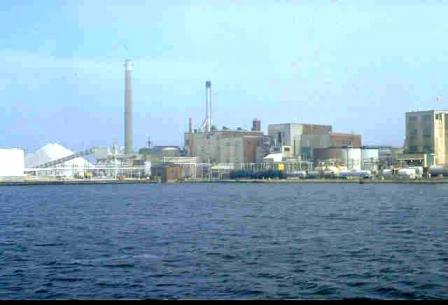Organic Chemicals, Plastics and Synthetic Fibers Effluent Guidelines
 EPA promulgated the Organic Chemicals, Plastics and Synthetic Fibers (OCPSF) Effluent Guidelines and Standards (40 CFR Part 414) in 1987, and amended the regulation in 1989, 1990, 1992 and 1993. The regulation covers wastewater discharges from more than 1,000 chemical facilities. The OCPSF Effluent Guidelines and Standards are incorporated into NPDES permits for direct dischargers
EPA promulgated the Organic Chemicals, Plastics and Synthetic Fibers (OCPSF) Effluent Guidelines and Standards (40 CFR Part 414) in 1987, and amended the regulation in 1989, 1990, 1992 and 1993. The regulation covers wastewater discharges from more than 1,000 chemical facilities. The OCPSF Effluent Guidelines and Standards are incorporated into NPDES permits for direct dischargersOn this page:
What is OCPSF?
The OCPSF category includes more than 1,000 chemical facilities producing over 25,000 end products, such as benzene, toluene, polypropylene, polyvinyl chloride, chlorinated solvents, rubber precursors, rayon, nylon, and polyester. The OCPSF industry is large and diverse, and many plants are highly complex. Some plants produce chemicals in large volumes through continuous chemical processes, while others produce only small volumes of "specialty" chemicals through batch chemical processes.
Facilities Covered
The OCPSF regulation applies to process wastewater discharges resulting from the manufacture of the products or product groups listed in the rayon fibers, other fibers, thermoplastic resins, thermosetting resins, commodity organic chemicals, bulk organic chemicals, and specialty organic chemicals subcategories. The products are included within the following SIC groups:
- 2821: Plastic Materials, Synthetic Resins, and Nonvulcanizable Elastomers
- 2823: Cellulosic Man-Made Fibers
- 2824: Synthetic Organic Fibers, Except Cellulosic
- 2865: Cyclic Crudes and Intermediates, Dyes, and Organic Pigments
- 2869: Industrial Organic Chemicals, Not Elsewhere Classified.
Note: This SIC listing is provided as a guide and does not define the coverage of the OCPSF regulations. For precise definitions of coverage, see the applicability sections in 40 CFR Part 414.
Subcategories
- General Requirements
- Rayon Fibers
- Other Fibers
- Thermoplastic Resins
- Thermosetting Resins
- Commodity Organic Chemicals
- Bulk Organic Chemicals
- Specialty Organic Chemicals
- Direct Discharge Point Sources That Use End-of-Pipe Biological Treatment
- Direct Discharge Point Sources That Do Not Use End-of-Pipe Biological Treatment
- Indirect Discharge Point Sources
Chlorine and Chlorinated Hydrocarbon Manufacturing
EPA began a new rulemaking in 2005 to address wastewater discharges from facilities that manufacture chlorine and certain chlorinated hydrocarbons (CCH). The Agency collected data on CCH facilities through 2007, and following a review of the information it discontinued the rulemaking in 2012.
Preliminary Study of Cellulose Product Manufacturing - 2011
EPA conducted a study of regenerated cellulose manufacturers, focusing on discharges of carbon disulfide (CS2). Cellulose products manufacturers use CS2 in the viscose process to break down aged alkali cellulose prior to regeneration. CS2 can enter the wastewater stream at these facilities from CS2 unloading and storage, the viscose process, CS2 recovery, and/or air pollution controls. Current effluent guidelines do not cover CS2 discharges.
Guidance Document
- Product and Product Group Discharges Subject to OCPSF Effluent Guidelines (2005)
Provides assistance to permit writers and regulated facilities in implementing the OCPSF regulation. Includes an explanation of the extensive chemical nomenclature in the regulation.
Rulemaking History
1993 Amendment
- Revised criteria for designating "metal-bearing" and "cyanide-bearing" waste streams
- Added Subpart J limitations for 19 additional pollutants (direct dischargers) and Subpart K limitations for 11 pollutants (indirect dischargers)
- Documents, including:
- Final Rule: 58 FR 36872, 7/9/1993
- Development Document - Supplement
1992 Amendment
- Alternative cyanide limitations for unavoidable complexing of cyanide at the process source of cyanide-bearing waste streams
- Allows control authorities to accommodate low background levels of metals in non-metal-bearing waste streams that result from the corrosion of construction materials, intake water, or other incidental metal sources
- Specifies the method of determining BOD and TSS limitations for plants that manufacture products in more than one subcategory
- Corrects listing errors in the appendices of the regulation
- Corrects subcategory listing errors for six product or product groups
- Documents, including:
- Final Rule: 57 FR 41836, 9/11/1992
1990 Amendment
Revoked selected portions of the regulations pursuant to litigation
- Documents, including:
- Final Rule: 55 FR 26691, 6/29/1990
1989 Amendment
Technical amendments and revocation of selected portions of the regulations
- Documents, including:
- Final Rule: 54 FR 27351, 6/27/1989
1987 Rulemaking
The OCPSF category replaced the Organics Chemicals Category and the Plastics and Synthetic Fibers Category. The latter two categories had been promulgated in 1974-76 and then withdrawn pursuant to litigation.
-
Documents, including:
-
Final Rule: 52 FR 42521, 11/5/1987
-
Development Document
Describes industry processes, pollutants generated, available control and treatment technologies, the technical basis for the final rule, and costs of the rule -
Proposed Rule: 48 FR 11828, 3/21/1983
-
Additional Information
For additional information regarding OCPSF Effluent Guidelines, please contact Samantha Lewis (lewis.samantha@epa.gov) or 202-566-1058.
